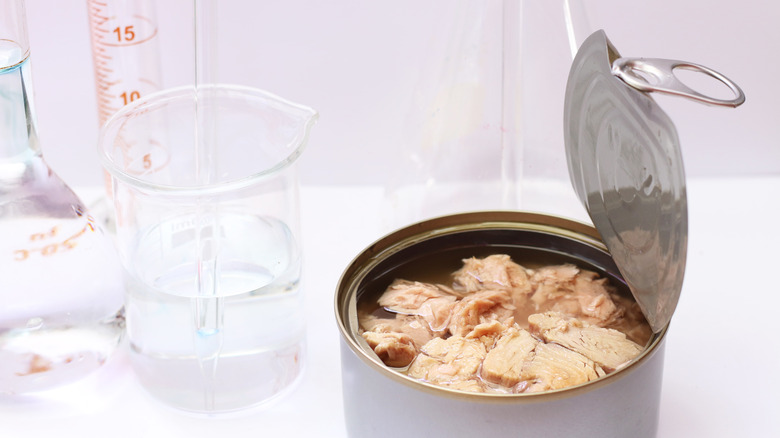How Is Mercury Tested In Tuna?
Mercury levels in fish — particularly canned tuna — is a prevalent concern. We'd like to think that there's a robust service that scans our tuna for mercury levels that exceed safe consumption. After all, it's impossible to know unless we test the fish at home or we start experiencing symptoms. Symptoms of high mercury levels include feeling as if insects are crawling underneath your skin, high blood pressure, swelling, and impaired cognitive function (per Vice). While these symptoms are profoundly uncomfortable for anyone, they are especially pronounced in pregnant people.
Because the testing of tuna is historically scattered, we can't be certain that the tuna we buy is indeed safe in larger quantities. In 2005, the Chicago Tribune reported how in the 1970s it took a chemistry professor's whim to test a can of tuna. The government tested the tuna, recalled 12 million cans, and declared the matter resolved. Similarly, in 2011, California discovered that mercury levels in store-bought fish and those used for sushi were high thanks to an investigation called Operation Seafood, led by the non-profit Got Mercury (per The Fish Site).
However, it seems that testing has improved in recent years. The FDA tested tuna as part of its report "An Exposure Assessment for Methylmercury from Seafood for Consumers in the United States," but even so, testing every tuna is impossible. According to a National Advertising Division report on Intrafish, Safe Catch is the only company that can claim to test every fish for mercury. The best one can hope for is the presence of a rigorous wide net of testing.
How mercury testing works
There are various ways to test tuna for mercury. According to regulations for pouched tuna from the United States Department of Agriculture (USDA), testing for mercury is conducted on three separate 3-ounce samples of tuna. The test is carried out 12 times at a minimum, and the mercury level cannot exceed 1 part per million. However, due to variance in fish size, it's technically possible for the USDA to miss mercury indicators.
How they test it is left unsaid. However, it is probably conducted in a similar manner to ConsumerLab's testing process. They explain that they replicate the digestive process by using sulfuric and nitric acid, which helps evaporate the mercury. Then, a device called an inductively coupled plasma-mass spectrometer examines the samples down to 0.007 parts per million. Essentially, you break the food apart and examine what remains.
If you lack a full chemistry lab, tuna could be theoretically tested at home. However, ConsumerLab does not think that a home test can accurately gauge the level of mercury in a tuna. The mercury tests made for home use are usually geared for liquids and, when used for solid foods, the process becomes more arduous. ConsumerLab details how one kit instructed them to mix tuna with distilled water and vinegar. Then the liquid must be heated, cooled, filtered, and filtered several times again. Until testing is more definitive, it's best to keep your weekly tuna consumption well under the recommended maximum amount.

